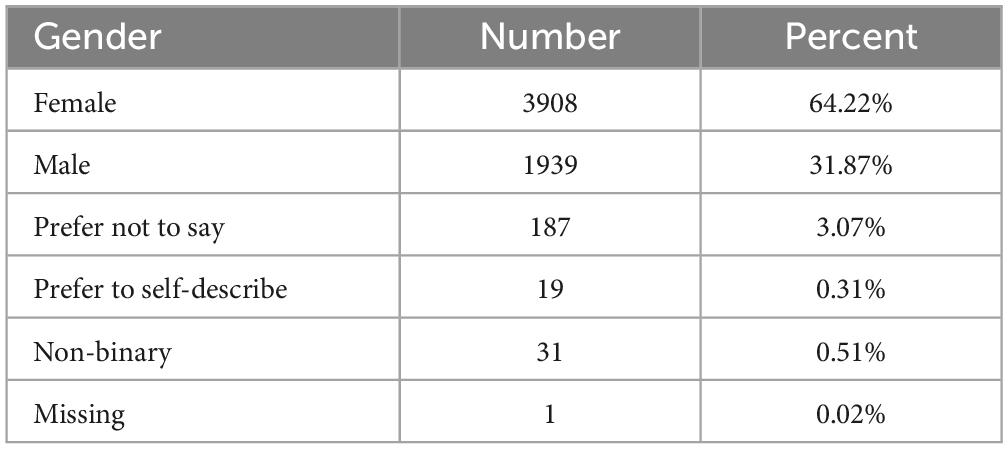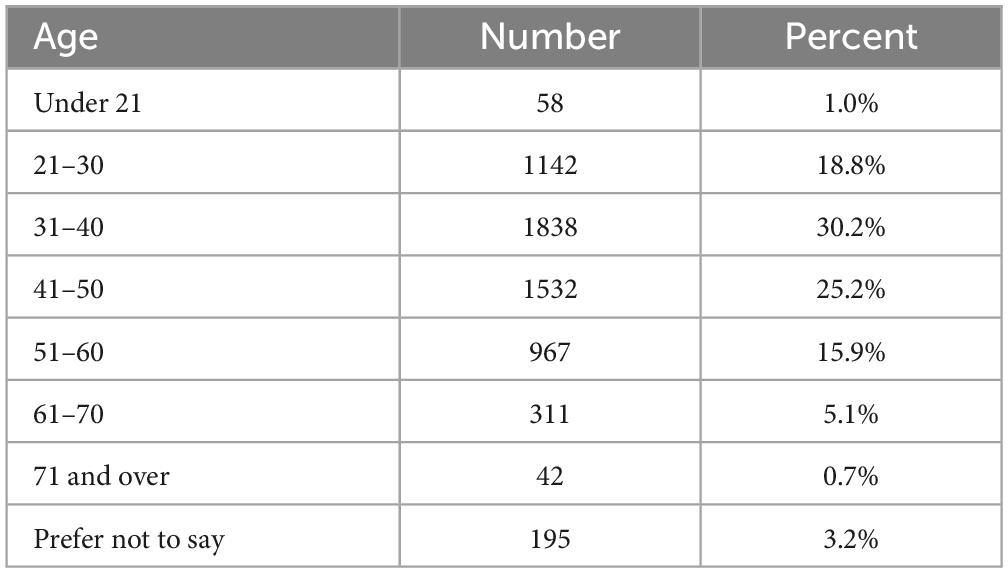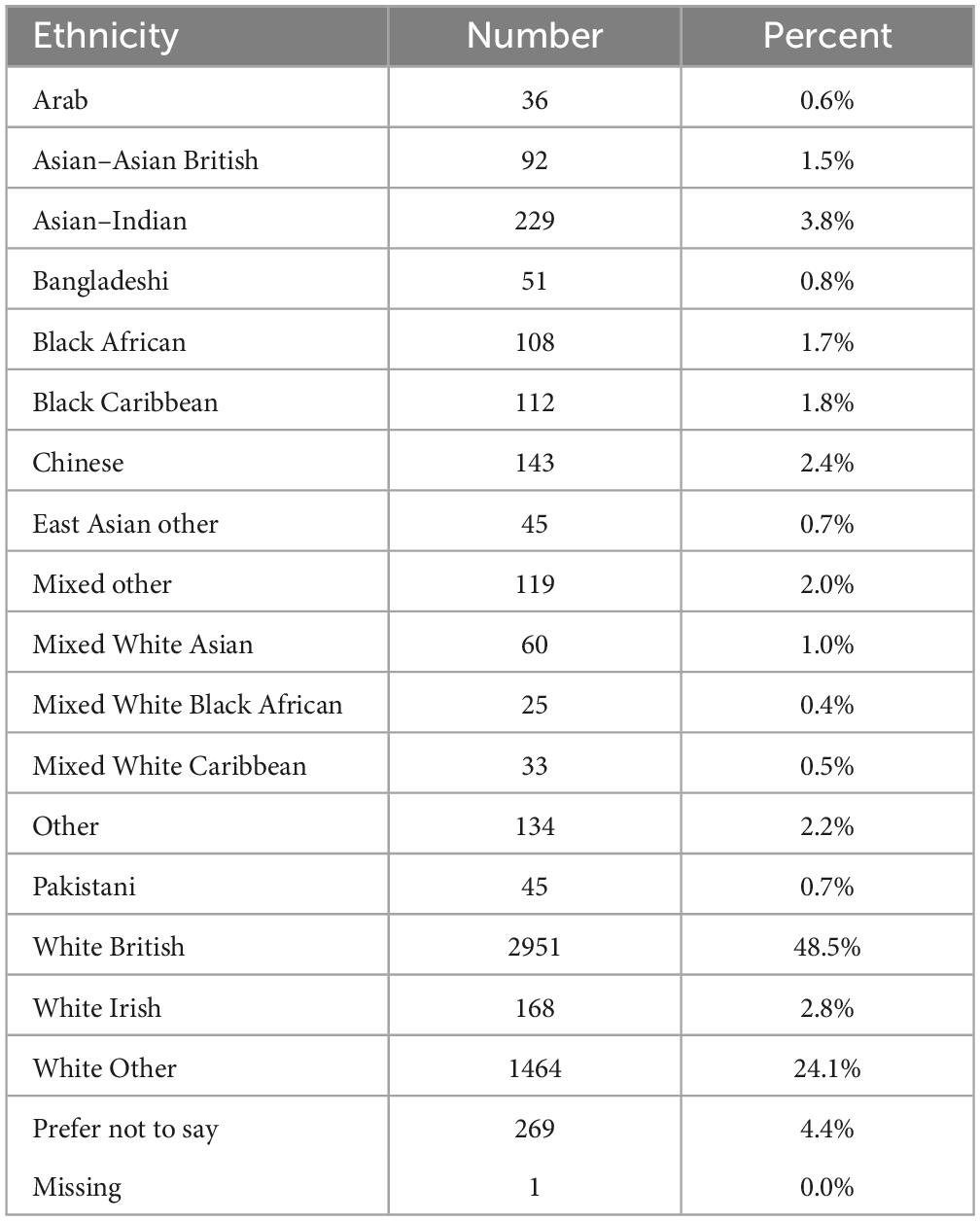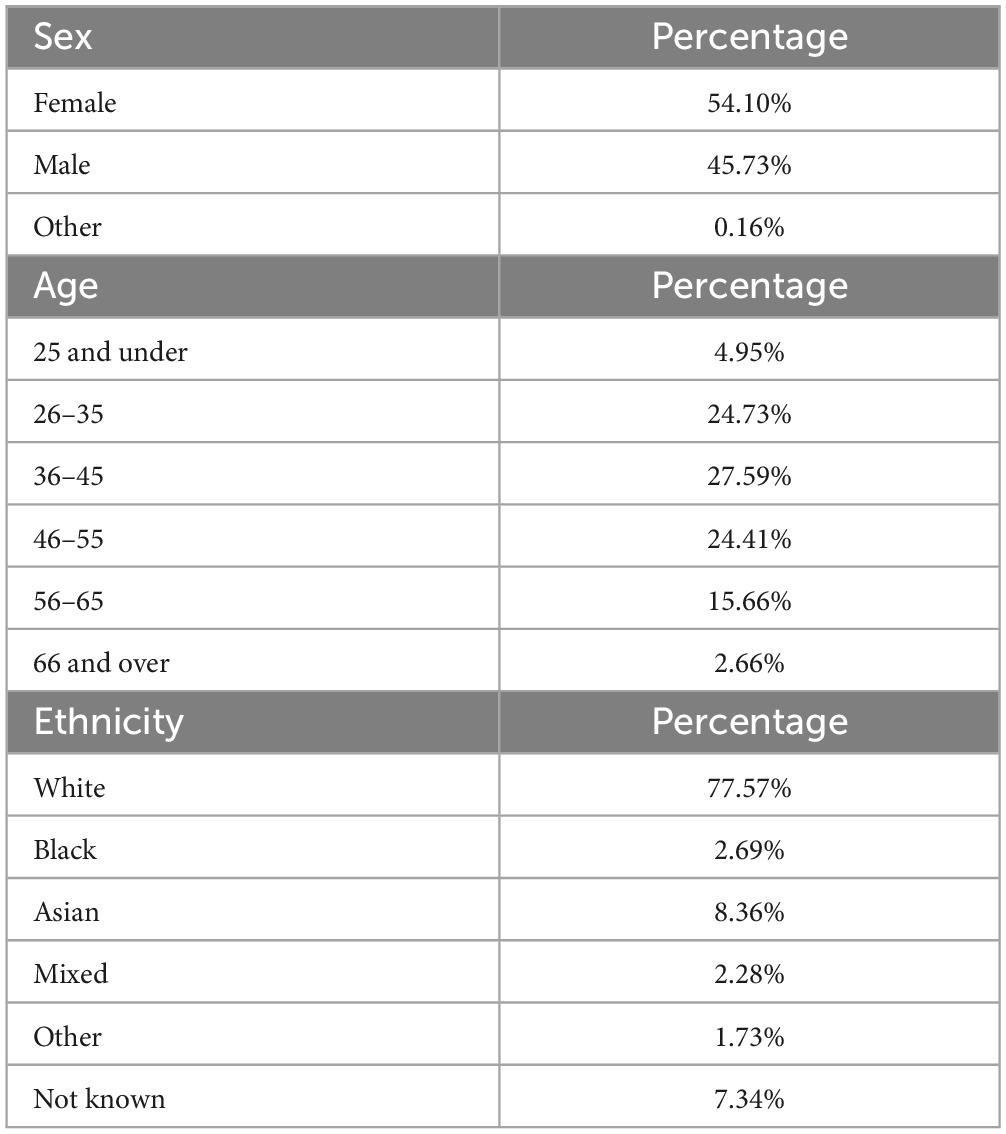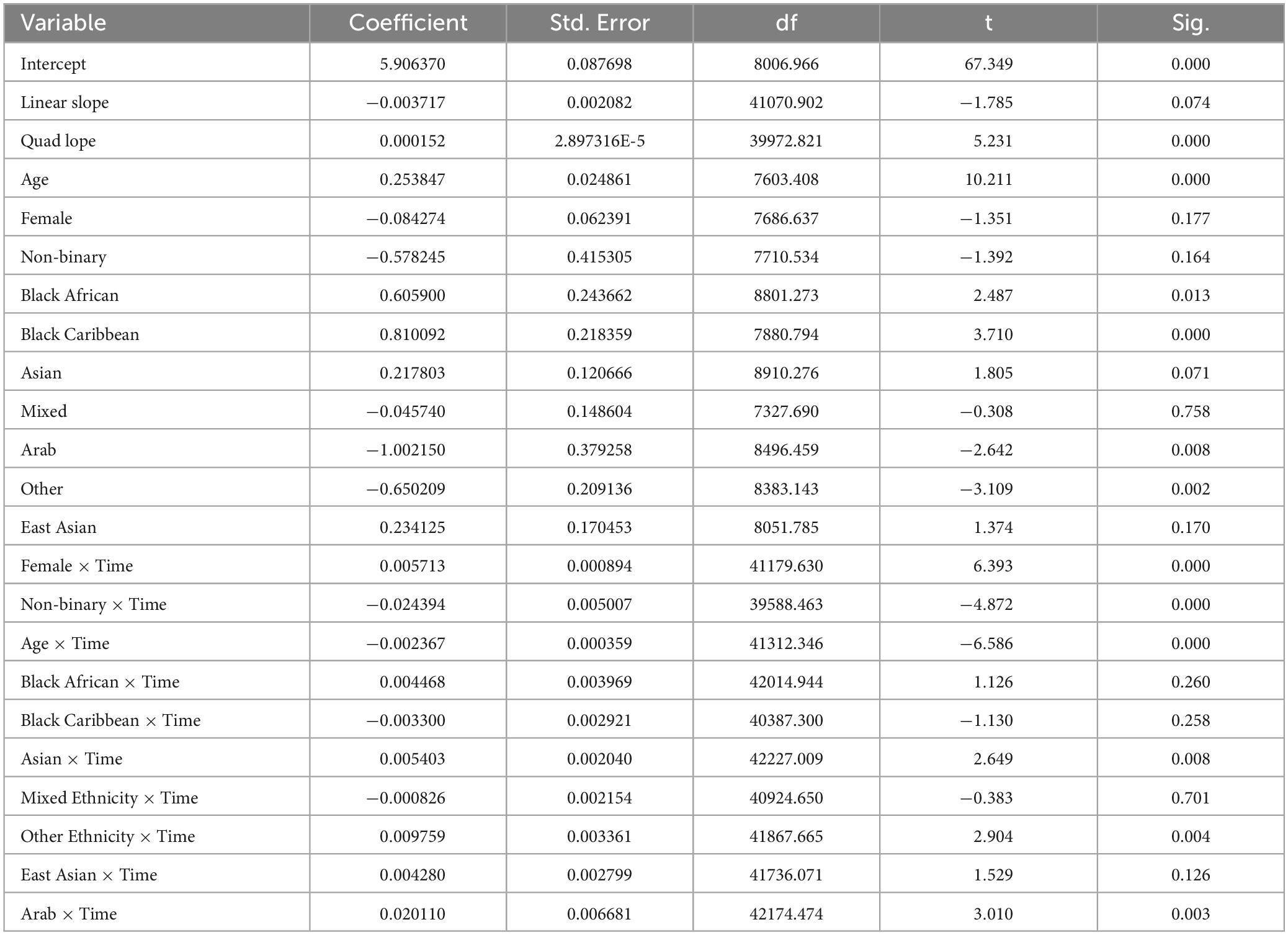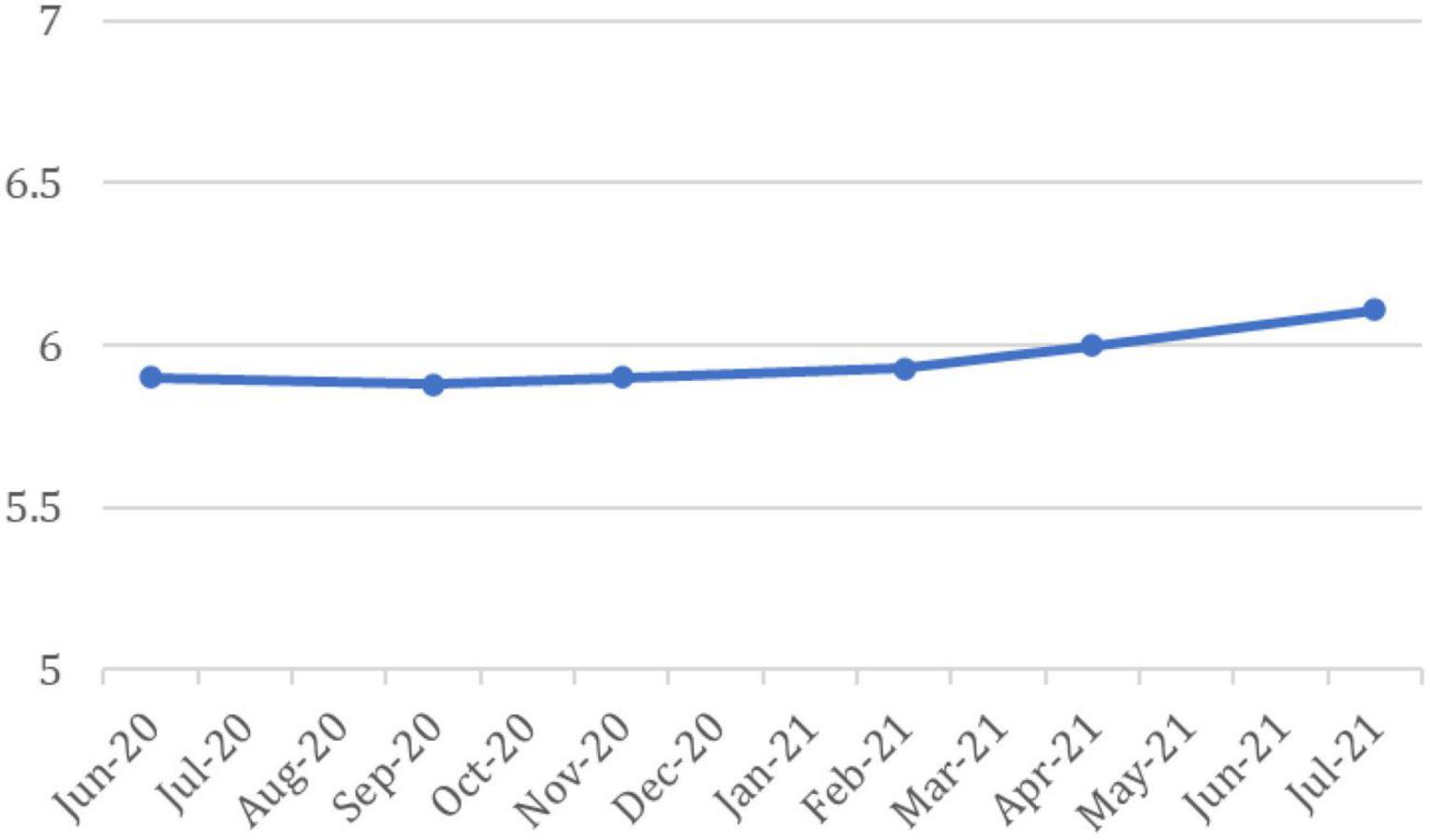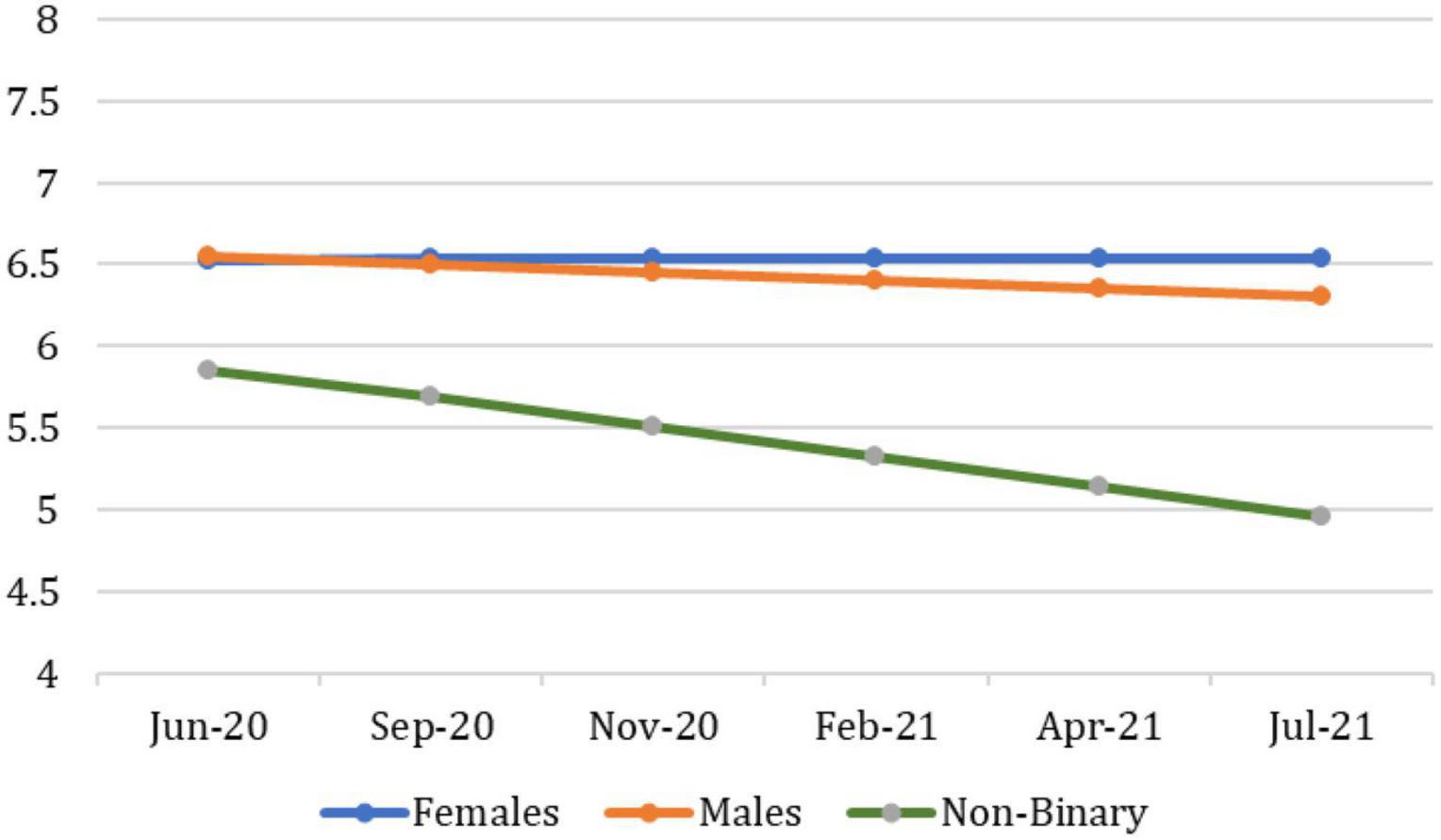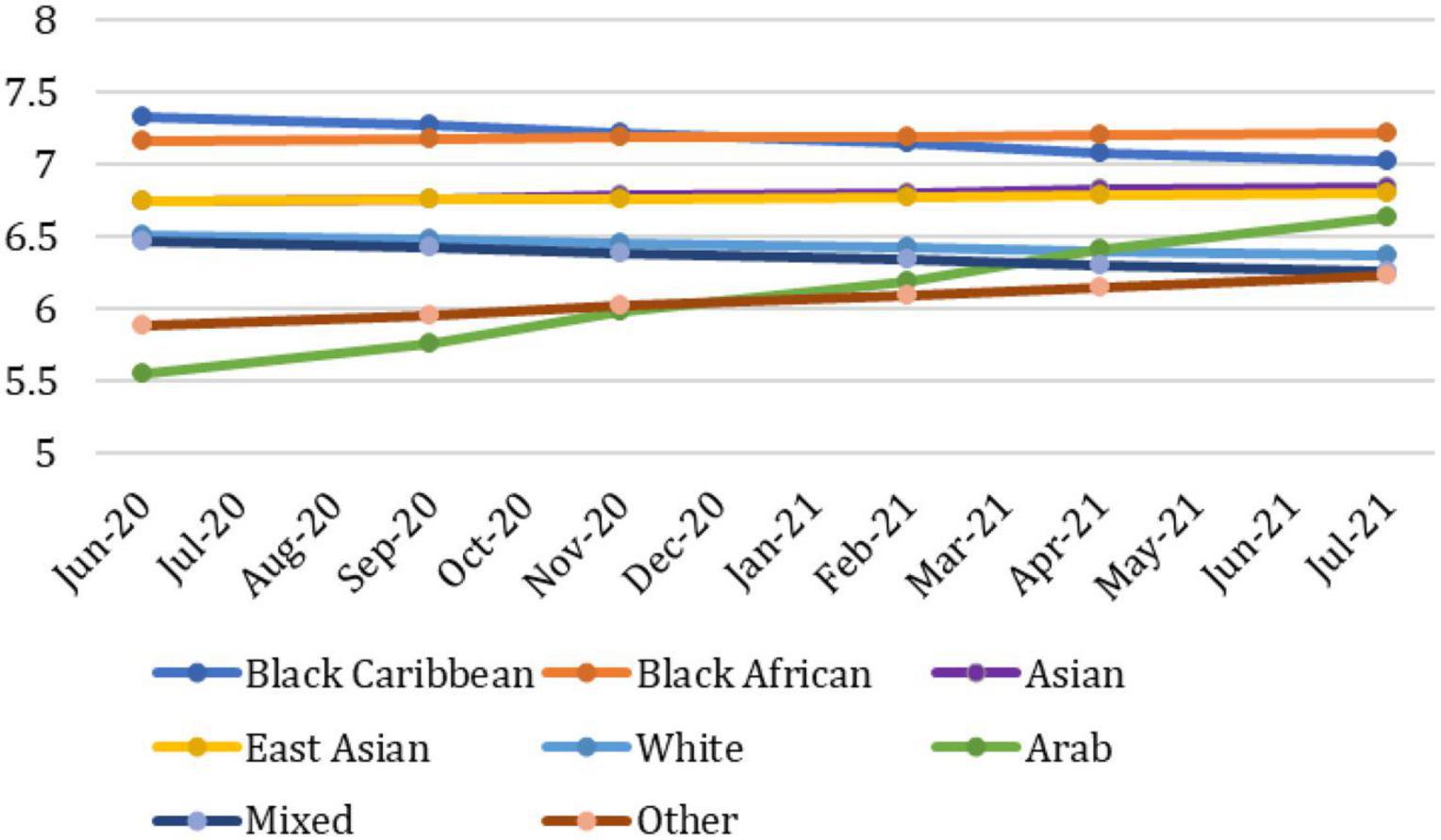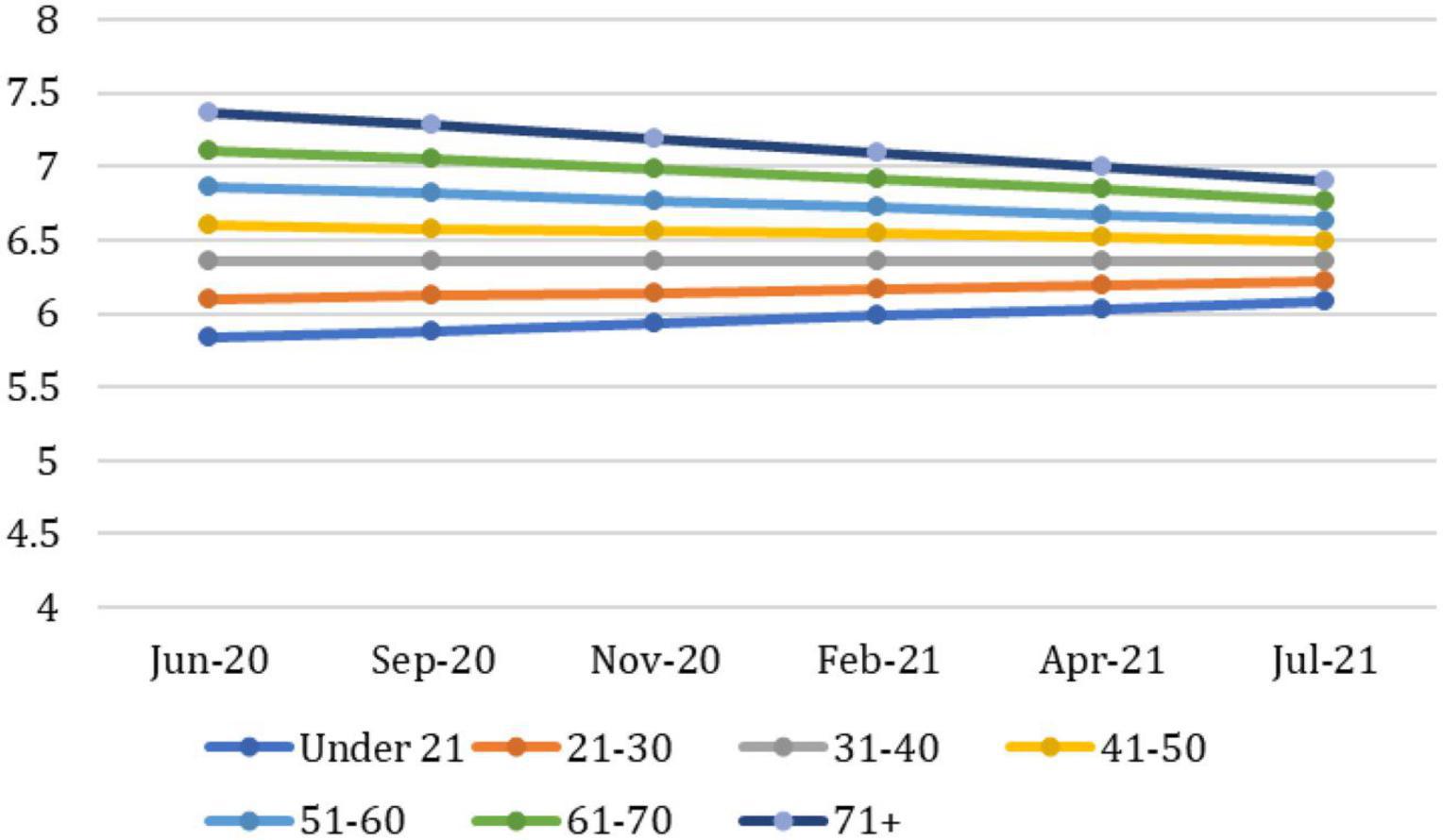- 1Institute for Sustainable Resources, The Bartlett School of Environment, Energy and Resources, University College London, London, United Kingdom
- 2Department of Clinical, Educational and Health Psychology, University College London, London, United Kingdom
This paper provides evidence of the trends in the emotional wellbeing of university staff during the COVID-19 pandemic, with a focus on differences according to age, gender and ethnicity. From June 2020 to July 2021 a survey was circulated to University College London staff, capturing information on self-described demographic indicators (age, gender, and ethnicity), satisfaction with academic life, and mental and emotional wellbeing. Results show a moderate level of emotional wellbeing overall, with scores increasing after lockdowns were lifted. Some significant heterogeneity within the demographic variables demonstrates the need for disaggregating the categories within Black and Minority Ethnic individuals. Black Caribbean and Black African staff reported higher levels of emotional wellbeing (respectively, 0.60 and 0.81 higher wellbeing scores, on average) while staff who identified as Arab or “other” reported lower levels (on average −1.0 and −0.65) than staff who identified as White. There was a sharp increase in emotional wellbeing for Arab staff and a slight increase in Asian and “other” ethnic staff. Findings from this research provide evidence into the trends in emotional wellbeing of faculty and staff in a United Kingdom university context, contributing to the literature focusing on higher education during the pandemic period. We also flag the importance of disaggregating Black and Minority Ethnic categorization to describe and better understand the diverse impact on emotional wellbeing within different ethnic groups, which has rarely been explored in the literature assessing university staff wellbeing.
1 Introduction
The COVID-19 pandemic drastically altered the structure of university life, with closures and lockdowns provoking a transition to virtual teaching formats at a previously unforeseen degree. A growing body of literature has assessed the impacts of virtual learning on students’ academic experiences, mental health, and emotional wellbeing (Aristovnik et al., 2020; Son et al., 2020; Wang and Zhao, 2020; Bashir et al., 2021) and considered adaptive teaching strategies (Johnson et al., 2020; Damşa et al., 2021; Peimani and Kamalipour, 2021). However, the transition’s impact on the mental and emotional wellbeing of university staff has often been overlooked (Urbina-Garcia, 2020; Peacock, 2022).
Studies have repeatedly found higher education employees to be at elevated risk of developing mental health problems and experiencing work-related stress (Watts and Robertson, 2011; Wray and Kinman, 2021). Factors such as overwhelming workloads, intense working pace, significant administrative burdens, research and teaching pressures, role conflicts, and lack of job support contribute to stress, anxiety, and burnout (Kinman and Wray, 2020; Urbina-Garcia, 2020; Dougall et al., 2021; Wray and Kinman, 2021). The issue has proven especially salient in the UK, where the results of national assessments conducted between 2008 and 2014 found work-related wellbeing among academic staff to be deteriorating over time (Kinman and Wray, 2020). More recent survey data confirm that the level of mental wellbeing among academic and academic-related employees is lower than the UK population norms (Wray and Kinman, 2021).
The shift to a virtual environment during COVID-19 brought benefits and challenges for university employees. Surveys of employees documented appreciation for time savings on their commute, greater autonomy, reduced distractions, and avoided stress from personal interactions as advantages of working remotely (Wray and Kinman, 2021). However, employees also reported an increase in workload to prepare online lectures, an expansion in the role of providing emotional support for students, and difficulties maintaining a work-life balance (Wray and Kinman, 2021). The mental and emotional toll of these challenges translated to higher levels of anxiety, stress and unhappiness among university employees as compared to the UK national average during lockdown (Shen and Slater, 2021; Watermeyer et al., 2021; Peacock, 2022). In an online survey of over 1,100 UK university employees, 47% of respondents described their mental health as “poor” and more than 50% of university staff reported feeling emotional exhaustion, stress, and worry (Dougall et al., 2021).
Demographic risk factors have been found to correlate with poor mental wellbeing during the pandemic. Some studies have found female employees to report higher levels of stress and anxiety as compared to male colleagues (Shen and Slater, 2021; Carr et al., 2022), although others have found no significant gender differences (Urbina-Garcia, 2020). Non-binary employees have also been found to have high levels of emotional distress (Van Der Feltz-Cornelis et al., 2020). Age has also correlated with differences in wellbeing, with older employees generally reporting better mental health (Wray and Kinman, 2021). Qualitative research suggests this age-related difference may reflect increased stresses for parents due to the lack of childcare and school closures during the multiple lockdowns in the UK (Gutman et al., 2023).
Surveys of university employees in the UK have rarely assessed ethnicity due to low sample size, leading those few studies considering ethnic differences to aggregate all Black and Minority Ethnic respondents together (Van Der Feltz-Cornelis et al., 2020; Wray and Kinman, 2021). One such UK study found that a greater proportion of respondents from ethnic minority groups reported having poor mental health (62%) compared with White respondents (45%) during the COVID-19 pandemic, though not statistically significant (Dougall et al., 2021). A survey of King’s College employees offered slightly greater disaggregation, finding Black and Minority Ethnic staff to be more likely to show probable depression, but only those reporting Asian ethnicity to reach statistical significance after adjusting for age and gender. Staff identifying as Asian were nearly twice as likely to report depression as White respondents (Carr et al., 2022). A qualitative study examining the lived experiences of diverse staff during the pandemic at a large, public research university in the UK found that Black, Asian and Minority Ethnic staff experienced specific work-related stresses pertinent to their ethnic identity including COVID-19 health inequalities and the Black Lives Matter movement (Gutman et al., 2023). Interviews with Black and Minority Ethnic students and staff in the US and the UK further elucidate the distinct challenges Black and Minority Ethnic individuals face in academic settings due to overt racism and discrimination, as well as lack of access to culturally appropriate services to manage these burdens (Arday, 2018; Cho and Brassfield, 2022). University staff, in particular, note that microaggressions, feelings of isolation and hyper-surveillance, and exclusionary work cultures contribute to increased stress and anxiety, but the toll of these burdens are often overlooked in university support systems (Arday et al., 2022; Cho and Brassfield, 2022).
Whilst universities have largely returned to on-campus instruction, some aspects of remote working have been retained. A nuanced understanding of the emotional states of university staff over the course of the pandemic can inform current university practice to promote the wellbeing of employees moving forward. The present study seeks to investigate the trends of emotional wellbeing for diverse university employees through secondary survey data gathered at the University College London (UCL), a major UK public research university. UCL collected weekly survey data from their employees over the pandemic period (56 weeks) asking a single question about their subjective wellbeing measured in terms of their emotional evaluations of their lives (Diener et al., 2003). The present study employed growth curve modeling to identify trends in emotional wellbeing, specifically considering differences based on gender, age, and ethnicity. Our research question can be summarized as: “How did the emotional wellbeing of university staff vary during the pandemic according to demographic factors including gender, age, and ethnicity, and how did these patterns change over time?”
2 Materials and methods
A weekly survey was developed by UCL Organizational Development team and circulated to all members of University College London (UCL) faculty and staff with active employee accounts for 56 weeks. The sample includes full-time, part-time, temporary, and contract employees. Results obtained from analyzing UCL faculty and staff could be generalized to other higher education institutions across the country, while in terms of both support during the pandemic and demographics characteristics other sectors could significantly differ. Completion was incentivized by the inclusion of respondents in a prize drawing for two iPads. Approval was received from UCL’s University Management Committee to distribute the survey. There was no random sampling as all staff could potentially participate, we can in fact define this as a closed cohort design study. Across the 56 weeks, there was the expectation to build a panel dataset, as faculty and staff could fill the survey every 7 days.
In total, 14,459 employees were contacted. Of this number, 42% (n = 6,085) completed the questionnaire at least once, and the average participant completed the survey 7.5 times. Obtaining a Panel Dataset was essential for effectively tracking changes over time. Similar to many other countries, UK residents initially faced the challenges of the first COVID-19 lockdown, followed by a series of closures and re-openings that significantly impacted their wellbeing in various ways. Respondents were asked 34 questions, including self-described demographic indicators (age, gender, and ethnicity), questions regarding satisfaction with academic life and professional support, and a question on mental and emotional wellbeing. Participants were asked to rate feelings of emotional wellbeing on a scale of 1 (low) to 10 (high). Responses were anonymized in the online system; Threshold limits, established at 5 for quantitative and 10 for qualitative responses, led to the non-disclosure of results in instances where the team received fewer responses, ensuring data privacy by concealing details when filters reduced the number of responders below the set thresholds. The categories used for demographics are the same as those used by UCL Organizational Development in the past, aiming to create a benchmark and facilitate result comparisons over time. A difference from previous versions of the questionnaires run internally is that the team decided to divide the questions on wellbeing in two, disentangling between emotional and physical wellbeing. Collected data was then analyzed using the Statistical Package for the Social Sciences (SPSS). Overall, this set of questions well covered the dimensions linked to wellbeing that researchers wanted to explore.
3 Results
3.1 Descriptive statistics
Tables 1–3 show the sociodemographic characteristics of the sample over the course of the study period. Female respondents were overrepresented (64.22%, n = 3,908) as compared to official reports that 53.5% of staff identify as female (University College London, 2021a). In terms of age, the sample aligns with official estimates although direct comparisons cannot be made due to differing age groupings.
In total, 18.04% (n = 1,098) of the sample identified as Black and Minority Ethnic and 75.32% (n = 4,583) identified as White British, White Irish, or White Other. Official statistics document that Black and Minority Ethnic staff make up 19% of staff and White staff make up 60% of staff, with the remaining 21.5% identifying as “unknown” or withholding their ethnicity (University College London, 2021b).
To discuss generalisability of results, statistics from Tables 1–3 were compared to what was collected by the UK Higher Education Statistics Agency (HESA)1 for the 2020/21 academic year. A summary of its report is available in Table 4; to note that the categories identified by HESA slightly differ from ours. Staff appears to be distributed quite similarly from an ethnicity perspective; only sex variable was available, making it difficult to comment on gender distribution overall.2 It terms of age, UCL staff seem to be slightly older, even if categories are different also in this case.
3.2 Data analysis
Statistical analyses were completed using SPSS 26. Growth curve modeling (GCM) was used to examine the trajectory of emotional wellbeing using the UCL Staff Weekly Wellbeing Survey.
In general, GCM is particularly well-suited for panel and longitudinal data due to its ability to capture individual trajectories over time,3 accommodating variations in baseline and growth parameters through the incorporation of random effects. This flexibility allows the model to handle unevenly spaced time points, making it ideal for longitudinal studies with irregular data collection schedules. Additionally, GCM adeptly addresses the challenge of missing data, providing robust estimates even in the presence of incomplete information. By capturing within-subject correlations, the model acknowledges the interdependence of observations within the same subject, enhancing its ability to discern patterns of change over time within diverse and dynamic longitudinal datasets. Considering its features, GCM is appropriate in this instance as not require equal spacing between time points and accounts for missing data which allows participants to be included if they have responded to the questionnaire at least twice.
Maximum likelihood estimation (MLE) was used to account for the missing data. MLE is an approach that involves finding parameter values maximizing the likelihood function, considering both observed and missing data. The likelihood function represents the probability of observing the data under the assumed model. The process includes imputing missing values based on the optimal parameters, aligning with the overall data pattern, providing estimates of uncertainty around imputed values and then ensuring the model captures underlying relationships.4
To examine the linear slope of the trajectory, a time variable corresponding to each week of the survey was created, with 0 representing the first week of the survey which was June 22, 2020, to 56 representing the final week of the survey which was July 19, 2021. To examine the quadratic slope of the trajectory, a quadratic variable was created by squaring the time variable. The covariates of gender, ethnicity, and age were also included in the model to determine if there are mean-level differences in emotional wellbeing. Including these covariates in our regression was crucial, given their extensive discussion in the literature; these factors typically account for significant variability in emotional wellbeing. In addition, interactions between these covariates and time, as well as these covariates and quadratic time were included to determine if there are time-related differences in emotional wellbeing across the linear and/or quadratic slopes. On the interactions, we wanted to further explore the decline in HE wellbeing over time reported by Kinman and Wray (2020), considering interactions with key covariates during a particularly difficult period. We also had some initial priors: in particular, considering age categories some were likely to cope less well with lockdowns (e.g., younger staff with childcare duties), while COVID-19 health inequalities and Black Lives Matter movement related stress may have negatively worsened wellbeing of staff with Black, Asian and Minority Ethnic identities.
Table 5 shows the final growth curve model with the coefficients and standard errors. Interactions between the covariates and quadratic time were not included in the final model due to non-significance. Emotional wellbeing, on average, is close to 6, with a significant linear decrease and a quadratic increase across time. As shown in Figure 1, emotional wellbeing remained fairly stable throughout 2020 but then increased slightly through July 2021.
For gender, there was a positive linear slope for female staff and a negative linear slope for non-binary staff. As shown in Figure 2, male and female staff reported similar levels of emotional wellbeing in June 2020 but there was a slight decrease in the emotional wellbeing of males across time. Non-binary staff reported a greater decline in their emotional wellbeing compared to males from June 2020 to July 2021. Table 5 reports no significant coefficients for other genders compared to males, however, while female participants slightly increase their scores over time non-binary participants have a decline with an average loss of 0.02 score points.
For ethnicity, Black Caribbean and Black African staff reported higher levels of emotional wellbeing and Arab and “other” ethnic staff reported lower levels of emotional wellbeing, on average, than staff who identified as White. There was a positive linear slope for Asian, Arab and other ethnic staff. As shown in Figure 3, there was a sharp increase in emotional wellbeing for Arab staff and a slight increase in Asian and other ethnic staff from June 2020 to July 2021. Table 5 shows how all ethnic categories except for Mixed Ethnicity have significant differences per se, as clearly visible in Figure 3; considering trends, the interactions between time and Black Caribbean, Black African, Mixed Ethnicity, and East Asian, do not have significant coefficients, while Asian, Other Ethnicity and Arabs staff increased their wellbeing score, respectively, by 0.005, 0.009, and 0.02 on average.
For age, older staff, on average, reported higher emotional wellbeing than younger staff. There was a negative linear slope for older staff. As shown in Figure 4, older UCL staff members reported higher emotional wellbeing than younger members, but the age gap narrowed from June 2020 to July 2021. This is consistent with Table 5, which reports a significantly positive coefficient for Age (0.25 points on average) and a decrease over time (−0.002).
4 Discussion
The present study sought to identify trends in emotional wellbeing across UCL staff throughout the COVID-19 pandemic. Over the course of 56 weeks, university employees were asked to rate their emotional wellbeing on a scale from one (low) to 10 (high). The results indicate a moderate level of emotional wellbeing but potential for improvement. On average, emotional wellbeing was rated at 6, increasing slightly over the period. However, demographic detail shows varying experiences depending on gender, age and ethnicity.
The emotional wellbeing of female respondents remained consistent with (or higher) than male respondents. Whilst the results differ from several studies that found female employees to be more likely to have probable depression and anxiety as compared to male employees (Souza et al., 2020; Van Der Feltz-Cornelis et al., 2020; Carr et al., 2022), it is not an outlier. Akour et al., 2020 and Wray and Kinman, 2021 also reported no differences between male and female university employees. These last findings from recent literature could suggest that an over-representation in terms of female participants may have limited effects in terms of bias, possibly enhancing the generalisability of results.
Only 0.5% (n = 31) of respondents identified as non-binary, and it was not possible to determine whether the sample representatively captured non-binary people, as staff identifying as non-binary are not captured in official statistics (University College London, 2021a). Non-binary staff were found to experience a lower overall rating of emotional wellbeing as compared to male staff, though not statistically significant (t = −1.392). However, the reported emotional wellbeing of non-binary participants declined at a statistically significant rate over time (t = −4.872). The trend is difficult to confirm due to the low sample size of non-binary participants (0.51% of respondents, n = 31), but it is consistent with the findings of an employee assessment at the University of York (Van Der Feltz-Cornelis et al., 2020). No studies investigating the specific challenges faced by non-binary individuals in a university context were identified, but general population surveys also found high levels of anxiety and depression amongst non-binary and transgender adults during the pandemic (Jarrett et al., 2020; Jacques-Aviñó et al., 2021). Unemployment, lack of access to gender-affirming care, and the inability to live according to one’s gender were found to be associated with poor mental wellbeing. On the small sample size, Meyer and Wilson (2009) concluded that failing to represent diversity adequately obscure variations or discarding valuable data from smaller subgroups: researchers should strategically focus on scientifically relevant groups and subgroups, ensuring an ample sample size to address research questions. When diversity is not fully included, it is essential to acknowledge and discuss this limitation, inviting further exploration by other researchers.
The present study found variations in emotional wellbeing across minority-ethnic groups. Staff who identified as Arab or “other” reported lower levels of emotional wellbeing than staff who identified as White. However, there was a sharp increase in emotional wellbeing for Arab staff and a slight increase in Asian and “other” ethnic staff over time. This differs from Carr et al. (2022), which found Asian respondents to be more likely to show probable depression. Carr et al. (2022) conducted a cross-sectional survey earlier in the pandemic (April 2020), whilst the present study was conducted from June 2020 to July 2021. Arab respondents saw the greatest change in emotional wellbeing over the period, rising from 5.6 to 6.7 over the period. This result is likely influenced by the small sample size (n = 36).
Black Caribbean and Black African staff (totaling to 3.6% of respondents) reported higher emotional wellbeing as compared to White staff. This result differs substantially from findings in the literature. A survey at King’s College found that Black staff were more likely to report probable depression as compared to White staff (Carr et al., 2022). Qualitative research found that Black and Minority Ethnic staff faced additional stresses and anxieties during the pandemic due to the Black Lives Matter movement and COVID-19 health inequalities (Gutman et al., 2023). Previous qualitative studies have further shown that Black and Minority Ethnic staff, particularly Black staff, report feeling isolated and burdened by often being in the minority (for instance, only 2% of UK professors are Black) (Walcott, 2021; Arday et al., 2022). These varied experiences demonstrate a limitation in aggregating all ethnic groups into the Black and Minority Ethnic category. Dougall et al. (2021) found that minority ethnic staff report lower mental health compared to white respondents while Van Der Feltz-Cornelis et al. (2020) found that there were no statistically significant differences due to ethnicity. However, the range demonstrated in this study yields very different insights.
Older staff reported consistently higher emotional wellbeing than younger staff. This is consistent with trends from the literature finding that older employees report higher levels of job satisfaction and are less susceptible to burnout (Van Der Feltz-Cornelis et al., 2020; Wray and Kinman, 2021; Carr et al., 2022). Generally, the mental health of young adults in the UK during COVID-19 lockdowns was found to be significantly lower and deteriorating as compared to other age groups (Banks and Xu, 2020). Qualitative evidence suggests this might be due to stresses with parenting young children during the pandemic in terms of juggling increased workloads with childcare and home schooling (Gutman et al., 2023). However, this study found that emotional wellbeing for staff under 40 years of age rose as lockdowns ended and in-person instruction was reintroduced. Older staff, instead, saw a decline in wellbeing, which could be influenced by continued higher risk of illness for these individuals in on-campus settings. Expectations to commute toward the Bloomsbury area may have caused stress and discomfort to staff within this age category, however we did not have a precise question within the survey that could confirm this.
To conclude, despite the significant and positive coefficient of the quadratic slope, as illustrated in Figure 1, interactions between the covariates and quadratic time were omitted from the final model due to their lack of significance. This suggests that the quadratic change in well-being may not be attributed to variability associated with other covariates considered in the interactions but rather to exogenous events, such as the easing of restrictions and the lifting of lockdown measures.
Limitations of this study include overrepresentation of select groups and small sample sizes. The disaggregation of ethnicity led to low recorded values of certain ethnic groups, which decrease the generalisability of results. Additionally, the profession of staff (i.e., academic vs. non-academic) was not captured. In the UK, academics report poorer work-life balance than non-academics (Fontinha et al., 2019). Controlling for the type of work to identify demographic differences within the same role may offer greater clarity on interventions. Another limitation concerns the measurement of emotional wellbeing, which was based on a single question. Given that the survey was designed and collected for the initial purposes of the university, the authors did not provide any input into the measurement of emotional wellbeing.
By design, surveys distilling emotional wellbeing to a rating do not yield insight into the drivers of low or high emotional wellbeing. While the results flag demographic factors that tie to a higher risk for poor emotional wellbeing, further work is needed to delve into the causes of these discrepancies. In the UK, very limited research has delved into the experiences of gender and sexual minorities during the pandemic, largely due to a lack of collecting gender identity in studies examining social impacts (McGowan et al., 2021).
As a panel study, the present work benefited from capturing emotional wellbeing over time. As mentioned in the section “2 Materials and methods,” the results of this research are generalisable to other higher education institutions. Demographics from HESA seem to be broadly similar to the UCL ones, and to the ones captured in our sample. In terms of replicability, the survey could be used to capture relevant information on wellbeing in other settings, in light of an ongoing crisis like COVID-19 to analyze how it changes during challenging periods. While employee emotional wellbeing prior to the pandemic could not be assessed due to a lack of data, the results of this analysis suggest a general increase in emotional wellbeing as the COVID-19 pandemic has eased. The findings support several literature trends, such as variations in emotional wellbeing due to age and gender identification, but also highlight the importance of disaggregating the Black and Minority Ethnic categorization to understand the diverse experiences of different ethnic groups. These findings can serve as an initial step to inform targeted initiatives to improve emotional wellbeing for all employees, provides evidence of the necessity to disaggregate the current ethnicity categorizations further, aiming for a more nuanced and inclusive understanding of wellbeing among Higher Education Staff.
From a policy standpoint, it is essential for mental health support initiatives within universities to not only refine ethnicity categorization in data collection from staff but also to design support sessions that recognize and incorporate diverse wellbeing needs. Tailoring ad-hoc support may be particularly pertinent for certain staff categories, as observed, for instance, when older staff faced specific challenges upon the lifting of lockdown measures.
5 Conclusion
In light of the tumultuous period brought about by the COVID-19 pandemic, this study has cast a spotlight on the emotional wellbeing of university staff. Over a span of 56 weeks, encompassing the pandemic’s various phases, this research collected data from UCL staff members. The results provide valuable insights into the emotional landscapes of these individuals, and its trend during the pandemic, offering nuanced perspectives based on gender, age, and ethnicity.
Overall, the emotional wellbeing of UCL staff, as measured on a scale from 1 (low) to 10 (high), can be characterized as moderate, with an average rating of 6. Notably, emotional wellbeing exhibited a slight upward trajectory as lockdowns were lifted, suggesting a degree of resilience and adaptability among university staff.
The study’s most noteworthy findings pertain to ethnicity. Black Caribbean and Black African staff reported higher emotional wellbeing than their White counterparts. Conversely, Arab and “other” ethnic staff reported lower emotional wellbeing on average than White staff, but it is crucial to note that Arab staff saw a substantial increase in emotional wellbeing during the study period.
Age also emerged as a crucial factor. Older staff consistently reported higher emotional wellbeing, aligning with broader research indicating that older employees tend to experience higher job satisfaction and are less susceptible to burnout. Surprisingly, younger staff experienced an improvement in emotional wellbeing as lockdowns ended, potentially influenced by the return to in-person instruction.
However, several limitations temper the study’s findings. The overrepresentation of specific groups, such as females and certain ethnicities, and the absence of data regarding the participants’ specific roles within the university pose challenges to generalizability. Moreover, emotional wellbeing measurement, based on a single question, may not fully capture the complexities of this construct.
In conclusion, this study provides valuable insights into the emotional wellbeing of university staff throughout the COVID-19 pandemic, highlighting the impact of gender, age, and ethnicity. It underscores the need for targeted initiatives to support the emotional wellbeing of all employees, particularly those who may be more vulnerable due to their demographic characteristics. Additionally, the study emphasizes the importance of disaggregating Black and Minority Ethnic categorizations to recognize the diverse experiences within different ethnic groups, offering greater understanding of emotional wellbeing in higher education during challenging times. These findings serve as a starting point to guide specific initiatives for enhancing emotional wellbeing among all employees. They highlight the need to further refine ethnicity categorizations, promoting a more nuanced and inclusive understanding of wellbeing among Higher Education Staff. More broadly, considering the literature used to evaluate our results, there is the need of further studies and evidence on examining demographic differences. University mental health policies should refine ethnicity categorization in staff data collection and design tailored support sessions to address diverse wellbeing needs, including specific challenges faced by certain staff categories during transitional periods.
Data availability statement
The raw data supporting the conclusions of this article will be made available by the authors, without undue reservation.
Ethics statement
Ethical approval was not required for the study involving human participants in accordance with the local legislation and institutional requirements. Written informed consent to participate in this study was not required from the participants in accordance with the national legislation and the institutional requirements.
Author contributions
LL: Conceptualization, Data curation, Investigation, Project administration, Resources, Supervision, Validation, Visualization, Writing – original draft, Writing – review and editing. IR: Investigation, Resources, Validation, Visualization, Writing – original draft. LM: Data curation, Formal analysis, Investigation, Methodology, Resources, Software, Validation, Visualization, Writing – review and editing.
Funding
The author(s) declare financial support was received for the research, authorship, and/or publication of this article. UCL Library will fund this publication.
Acknowledgments
We wish to thank Kate Faxen, Marija Popova and Coen Sandra for supporting us and providing the anonymised dataset. We also thank UCL Organizational Development Team.
Conflict of interest
The authors declare that the research was conducted in the absence of any commercial or financial relationships that could be construed as a potential conflict of interest.
Publisher’s note
All claims expressed in this article are solely those of the authors and do not necessarily represent those of their affiliated organizations, or those of the publisher, the editors and the reviewers. Any product that may be evaluated in this article, or claim that may be made by its manufacturer, is not guaranteed or endorsed by the publisher.
Footnotes
- ^ https://www.hesa.ac.uk/data-and-analysis/staff/table-27
- ^ ONS statistics on gender: https://www.ons.gov.uk/peoplepopulationand community/culturalidentity/genderidentity/bulletins/genderidentityengland andwales/census2021
- ^ A more complete review is offered in Von Rosen (1991).
- ^ To know more about MLE within GCM, please review Pan et al. (2002).
References
Akour, A., Ala’a, B., Barakat, M., Kanj, R., Fakhouri, H. N., and Malkawi, A. & Musleh, G. (2020). The impact of the COVID-19 pandemic and emergency distance teaching on the psychological status of university teachers: a cross-sectional study in Jordan. Am. J. Trop. Med. Hygiene 103, 2391–2399. doi: 10.4269/ajtmh.20-0877
Arday, J. (2018). Understanding mental health: what are the issues for black and ethnic minority students at university? Soc. Sci. 7:196. doi: 10.3390/socsci7100196
Arday, J., Branchu, C. and Boliver, V., (2022). What do we know about black and minority ethnic (BAME) participation in UK higher education? Soc. Policy Soc. 21, 12–25. doi: 10.1017/S1474746421000579
Aristovnik, A., Keržič, D., Ravšelj, D., Tomaževič, N. and Umek, L. (2020). Impacts of the COVID-19 pandemic on life of higher education students: a global perspective. Sustainability 12:8438. doi: 10.1016/j.dib.2021.107659 doi: 10.3390/su12208438
Banks, J. and Xu, X. (2020). The mental health effects of the first two months of lockdown during the COVID-19 pandemic in the UK. Fiscal Stud. 41, 685–708. doi: 10.1111/1475-5890.12239
Bashir, A., Bashir, S., Rana, K., Lambert, P. and Vernallis, A. (2021). Post-COVID-19 adaptations; the shifts towards online learning, hybrid course delivery and the implications for biosciences courses in the higher education setting. Front. Educ. 6:711619. doi: 10.3389/feduc.2021.711619
Carr, E., Davis, K., Bergin-Cartwright, G., Lavelle, G., Leightley, D. and Oetzmann, C. (2022). Mental health among UK university staff and postgraduate students in the early stages of the COVID-19 pandemic. Occup. Environ. Med. 79, 259–267. doi: 10.1136/oemed-2021-107667
Cho, K. S. and Brassfield, L. (2022). *An afterthought: staff of color and campus wellness within higher education responses to COVID-19. Am. Behav. Sci. 67. doi: 10.1177/00027642221118254
Damşa, C., Langford, M., Uehara, D. and Scherer, R. (2021). Teachers’ agency and online education in times of crisis. Comput. Hum. Behav. 121:106793. doi: 10.1016/j.chb.2021.106793
Diener, E., Oishi, S., and Lucas, R. E. (2003). Personality, culture, and subjective well-being: emotional and cognitive evaluations of life. Annu. Rev. Psychol. 54, 403–425. doi: 10.1146/annurev.psych.54.101601.145056
Dougall, I., Weick, M. and Vasiljevic, M. (2021). Inside UK Universities: Staff Mental Health and Wellbeing During the Coronavirus Pandemic. England: Durham University doi: 10.31234/osf.io/23axu
Fontinha, R., Easton, S., and Van Laar, D. (2019). Overtime and quality of working life in academics and nonacademics: the role of perceived work-life balance. Int. J. Stress Manag. 26, 173–183. doi: 10.1037/str0000067
Gutman, L. M., Younas, F., Perowne, R. and O’Hanrachtaigh, E. (2023). *Lived experiences of diverse university staff during COVID-19: an examination of workplace wellbeing. Studies in Higher Education. New York: Taylor & Francis doi: 10.1080/03075079.2023.2231015
Jacques-Aviñó, C., López-Jiménez, T., Medina-Perucha, L., de Bont, J., and Berenguera, A. (2021). Social conditions and mental health during COVID-19 lockdown among people who do not identify with the man/woman binomial in Spain. PLoS One 16:e0256261. doi: 10.1371/journal.pone.0256261
Jarrett, B. A., Peitzmeier, S. M., Restar, A., Adamson, T., Howell, S. and Baral, S. (2020). Gender-affirming care, mental health, and economic stability in the time of COVID-19: a global cross-sectional study of transgender and non-binary people. MedRxiv [Preprint]. doi: 10.1101/2020.11.02.20224709
Johnson, N., Veletsianos, G. and Seaman, J. (2020). US faculty and Administrators’ experiences and approaches in the early weeks of the COVID-19 pandemic. Online Learn. 24, 6–21. doi: 10.24059/olj.v24i2.2285
Kinman, G. and Wray, S. (2020). Well-being in academic employees–a benchmarking approach. in Handbook of Research on Stress and Well-being in the Public Sector, eds R. J. Burke S. Pignata. Cheltenham: Edward Elgar Publishing. doi: 10.4337/9781788970358.00019
McGowan, V. J., Lowther, H. J. and Meads, C. (2021). Life under COVID-19 for LGBT+ people in the UK: systematic review of UK research on the impact of COVID-19 on sexual and gender minority populations. BMJ open 11:e050092. doi: 10.1136/bmjopen-2021-050092
Meyer, I. H., and Wilson, P. A. (2009). Sampling lesbian, gay, and bisexual populations. J. Couns. Psychol. 56, 23–31. doi: 10.1037/a0014587
Pan, J. X., Fang, K. T., Pan, J. X. and Fang, K. T. (2002). *Maximum likelihood estimation. Growth Curve Models and Statistical Diagnostics. Berlin: Springer doi: 10.1007/978-0-387-21812-0_3
Peacock, J. (2022). University employees’ perceptions of health during the early stages of the COVID-19 pandemic. J. Further High. Educ. 46, 107–114. doi: 10.1080/0309877X.2021.1887464
Peimani, N. and Kamalipour, H. (2021). Online education and the COVID-19 outbreak: a case study of online teaching during lockdown. Educ. Sci. 11:72. doi: 10.3390/educsci11020072
Shen, P. and Slater, P. (2021). The effect of occupational stress and coping strategies on mental health and emotional well-being among university academic staff during the COVID-19 outbreak. Int. Educ. Stud. 14, 82–95. doi: 10.5539/ies.v14n3p82
Son, C., Hegde, S., Smith, A., Wang, X. and Sasangohar, F. (2020). Effects of COVID-19 on college students’ mental health in the United States: interview survey study. J. Med. Int. Res. 22:e21279. doi: 10.2196/21279
Souza, A. P. D. S., Silva, M. R. M., Silva, A. B. J. D., Lira, P., Silva, J. M. L. D. and Silva, M. (2020). Anxiety symptoms in university professors during the covid-19 pandemic. Health Sci. J. 14:773.
University College London (2021a). Staff Numbers by Gender and Faculty/Service Area as on 01/10/2021. Available online at: https://www.ucl.ac.uk/human-resources/sites/human_resources/files/october_2021_c_staff_numbers_by_gender_ and_faculty_areas.pdf (Accessed 6 January 2023).
University College London (2021b). Staff Numbers by Ethnicity and Faculty/Service Area as on 01/10/2021. Available online at: https://www.ucl.ac.uk/human-resources/sites/human_resources/files/october_2021_e_staff_numbers_by_ethnicity_ and_faculty_areas.pdf (Accessed 6 January 2023).
Urbina-Garcia, A. (2020). What do we know about university academics’ mental health? a systematic literature review. Stress Health 36, 563–585. doi: 10.1002/smi.2956
Van Der Feltz-Cornelis, C. M., Varley, D., Allgar, V. L. and De Beurs, E. (2020). Workplace stress, presenteeism, absenteeism, and resilience amongst university staff and students in the COVID-19 lockdown. Front. Psychiatry 11:588803. doi: 10.3389/fpsyt.2020.588803
Von Rosen, D. (1991). The growth curve model: a review. Commun. Stat. Theory Methods 20, 2791–2822. doi: 10.1080/03610929108830668
Walcott, R. (2021). Fighting back while black: the relationship between racialised resistance and well-being. in Doing Equity and Diversity for Success in Higher Education, eds D. S. P. Thomas and J. Arday. Cham: Palgrave Macmillan doi: 10.1007/978-3-030-65668-3_19
Wang, C. and Zhao, H. (2020). The impact of COVID-19 on anxiety in Chinese university students. Front. Psychol. 11:1168. doi: 10.3389/fpsyg.2020.01168
Watermeyer, R., Crick, T., Knight, C. and Goodall, J. (2021). COVID-19 and digital disruption in UK universities: afflictions and affordances of emergency online migration. High. Educ. 81, 623–641. doi: 10.1007/s10734-020-00561-y
Watts, J. and Robertson, N. (2011). Burnout in university teaching staff: a systematic literature review. Educ. Res. 53, 33–50. doi: 10.1080/00131881.2011.552235
Keywords: emotional wellbeing, pandemic, higher education, BME, Black and Minority Ethnic, gender, age differences, equality diversity and inclusion
Citation: Lotti L, Ragazzi I and Morrison Gutman L (2024) Trends in emotional wellbeing during COVID-19 by ethnicity, age and gender: evidence from a higher education staff survey. Front. Educ. 8:1279200. doi: 10.3389/feduc.2023.1279200
Received: 17 August 2023; Accepted: 28 December 2023;
Published: 17 January 2024.
Edited by:
Aleksander Aristovnik, University of Ljubljana, SloveniaReviewed by:
Marcela Alina Farcasiu, Politehnica University of Timişoara, RomaniaJorge Ignacio Maluenda-Albornoz, San Sebastián University, Chile
Mostafa Rezapour, Wake Forest University School of Medicine, United States
Copyright © 2024 Lotti, Ragazzi and Morrison Gutman. This is an open-access article distributed under the terms of the Creative Commons Attribution License (CC BY). The use, distribution or reproduction in other forums is permitted, provided the original author(s) and the copyright owner(s) are credited and that the original publication in this journal is cited, in accordance with accepted academic practice. No use, distribution or reproduction is permitted which does not comply with these terms.
*Correspondence: Lorenzo Lotti, bC5sb3R0aUB1Y2wuYWMudWs=
 Lorenzo Lotti
Lorenzo Lotti Isabella Ragazzi1
Isabella Ragazzi1